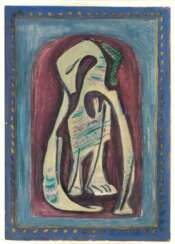aljeksandra powòrina (1885 - 1963)

Aleksandra Andreevna Povorina (Russian: Александра Андреевна Поворина), married Ahlers-Hestermann, was a Russian and German modernist painter.
Aleksandra was born in the family of a St. Petersburg civil servant, in 1913 she went to Paris, where she studied at the Russian Academy of M. Vasilieva, joined the circle of artists of the Paris School, became interested in the art of Cézanne and Matisse. In Paris she met the artist from Hamburg Friedrich Ahlers-Hestermann (1883-1973), who became her husband. With the outbreak of World War I, the family moved to Hamburg.
Since 1915 the artist created semi-abstract paintings, participated in group exhibitions at the Commeter Gallery, was a member of the newly created Hamburg Secession with her husband. Under the influence of Paul Cézanne and Henri Matisse, she developed a spiritual-abstract art.
In 1934, the National Socialists who came to power in Germany banned Aleksandra and Friedrich any activity, and abstract paintings Povorina were recognized as degenerate. At that time the artist took up textile design, creating abstract patterns for fabrics, at the same time a series of black and white graphic ink drawings were created. During the war, many of the artist's works were destroyed.
After the end of World War II, Aleksandra took a teaching position at the Weissensee Higher Art School in Berlin, creating abstract collages. After her death, her daughter, textile, mosaic and glass artist Tatjana Ahlers-Hestermann, completed some of her works.


Aleksandra Andreevna Povorina (Russian: Александра Андреевна Поворина), married Ahlers-Hestermann, was a Russian and German modernist painter.
Aleksandra was born in the family of a St. Petersburg civil servant, in 1913 she went to Paris, where she studied at the Russian Academy of M. Vasilieva, joined the circle of artists of the Paris School, became interested in the art of Cézanne and Matisse. In Paris she met the artist from Hamburg Friedrich Ahlers-Hestermann (1883-1973), who became her husband. With the outbreak of World War I, the family moved to Hamburg.
Since 1915 the artist created semi-abstract paintings, participated in group exhibitions at the Commeter Gallery, was a member of the newly created Hamburg Secession with her husband. Under the influence of Paul Cézanne and Henri Matisse, she developed a spiritual-abstract art.
In 1934, the National Socialists who came to power in Germany banned Aleksandra and Friedrich any activity, and abstract paintings Povorina were recognized as degenerate. At that time the artist took up textile design, creating abstract patterns for fabrics, at the same time a series of black and white graphic ink drawings were created. During the war, many of the artist's works were destroyed.
After the end of World War II, Aleksandra took a teaching position at the Weissensee Higher Art School in Berlin, creating abstract collages. After her death, her daughter, textile, mosaic and glass artist Tatjana Ahlers-Hestermann, completed some of her works.


Aleksandra Andreevna Povorina (Russian: Александра Андреевна Поворина), married Ahlers-Hestermann, was a Russian and German modernist painter.
Aleksandra was born in the family of a St. Petersburg civil servant, in 1913 she went to Paris, where she studied at the Russian Academy of M. Vasilieva, joined the circle of artists of the Paris School, became interested in the art of Cézanne and Matisse. In Paris she met the artist from Hamburg Friedrich Ahlers-Hestermann (1883-1973), who became her husband. With the outbreak of World War I, the family moved to Hamburg.
Since 1915 the artist created semi-abstract paintings, participated in group exhibitions at the Commeter Gallery, was a member of the newly created Hamburg Secession with her husband. Under the influence of Paul Cézanne and Henri Matisse, she developed a spiritual-abstract art.
In 1934, the National Socialists who came to power in Germany banned Aleksandra and Friedrich any activity, and abstract paintings Povorina were recognized as degenerate. At that time the artist took up textile design, creating abstract patterns for fabrics, at the same time a series of black and white graphic ink drawings were created. During the war, many of the artist's works were destroyed.
After the end of World War II, Aleksandra took a teaching position at the Weissensee Higher Art School in Berlin, creating abstract collages. After her death, her daughter, textile, mosaic and glass artist Tatjana Ahlers-Hestermann, completed some of her works.






